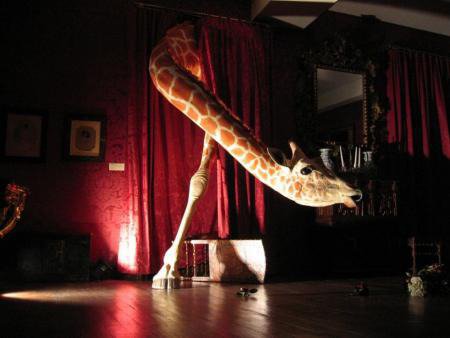Jean-Francois Fourtou
dal 13/1/2011 al 25/2/2011
Segnalato da
13/1/2011
Jean-Francois Fourtou
Aeroplastics Contemporary, Bruxelles
Fallen from the sky. This second exhibition at the gallery is an opportunity to take stock of artist's recent works, and particularly his projects at Dar el Sadaka in Marrakech (Morocco) where he lives and has his studio.

This second exhibition of Jean-François Fourtou at the gallery is an opportunity to take stock of his recent works, and particularly his projects at Dar el Sadaka in Marrakech (Morocco) where he lives and has his studio.
Born in Paris in 1964, Jean-François Fourtou lived for a time in Madrid and then in New York. He became known in the 1990s for his unique sculptures of animals - lambs, giraffes, snails, and orangutans, among others - following the inspiration of François Pompom. However, there is a fine distinction: Fourtou is less interested in animals from a naturalist's point of view than he is to evoking the world of childhood, half-magical, half- remembered, and most of all, his own. From his perspective, the other-than-human animal is a figure simultaneously emotional and hard to place, living in a world where not everything is known, remaining as mysterious as it is physically and absurdly present, and installed in places where it does not belong but which it seems to occupy with great self- assurance. These animals are photographed in incongruous settings - an executive office, a café - and the insistent presence of these witnesses of the universe internalizes the relationship of existence, making it unfamiliar and opening an unexpected door, the self- portrait. Instead of being a depiction of the self, setting forth the image of the self, the self- portrait renders more sharply the symbolic theme of emotional attachments: cherished animals, often more loveable and supportive than humans.
The self-portrait that Jean-François Fourtou constructs sculpturally finds its expressiveness through the astonishing art of re-creation. The objects of his focus are cabins, houses, interiors, hiding places, actual places that have disappeared - so many vital elements in the frame of reference of his existence. Created on different scales, they are intimately linked to parts of his personal life. These places are living spaces: his grandmother's room, appearing like that of a giantess, where furniture and objects, broom and chamber pot, are immense, in the proportions perceived by the artist as a child; the bedroom of his daughter, still a child, seems reserved for Lilliputians, where an adult has to stoop to enter. Playing with physical scale becomes playing with time, giving it a material consistency. Remembering seems not enough for him. He has to reconstruct it, relive the experience, turning back time and, with the greatest accuracy possible in the execution, experience vanished moments. He reoccupies the past by interposing a reconstructed décor with the original appearance but with changed scale. Art in this instance gives a patina of age and creates a warp in time and space. A skillful rendering, as intensely disturbing as it is moving.
Jean-François Fourtou's major work, in progress for a decade, has the unexpected form of a construction site in a neighborhood of Marrakech, in the form of a synthesis - as in Ingres' "Masterpiece", a painting in which the Master of Montauban focused all his artistic concerns and private obsessions. Fourtou's objective: to gather in one site all of his works and obsessions, as did Ingres. Shaped day after day with this intention, the property of Dar el Sadaka today contains within its 25 acres at the foot of the Atlas Mountains a unique project: an incongruous bestiary, with sculptured horses, giraffes, and geese; the interior of traditional houses re-created for people big and small; a house in the Charente region (as a child, the artist used to spend his holidays in Fouras) reproduced to scale, as if it had fallen from the sky and landed on its roof in a field surrounded by olive trees, and which can only be entered through a window by means of a ladder. How to define this experiment as a spectator looking on this field of self-absorption? By letting one's mind mull over it, overburdened with its own past? The art of the self-taught, so dear to André Breton - the Facteur Cheval, Picassiette, Vivien - photographed in their homes, formerly by Gilles Ehrman, is not so far removed. In the "Gesamtkunstwerk" (total masterpiece), the aesthetic universe of Jean-François Fourtou merges with his real life, a "Recherche du Temps perdu" that abandons all nostalgia and replaces it with archaeology and rebirth - like a tangible reincarnation with all its effect.
Paul Ardenne
Academic and art historian Paul Ardenne is the author of numerous works on the current cultural scene, notably: Contemporary Art (1997), Contextual Art (2002), Extreme (2006), and Art of the Present (2009). He is a regular contributor to the journals Artpress and Archistorm.
Image: Jean-François Fourtou: Girafe, 2003
Unique, sculpture, life-size, resin, paint, fabric, 270 x 180 x 260 cm, 106.3 x 70.9 x 102.4 inches
Aeroplastics Contemporary
32 rue Blanche 1060 - Brussels
Opening Hours: Tues-Fri 11 am - 6 pm, Sat 2 - 6 pm, and by appointment



